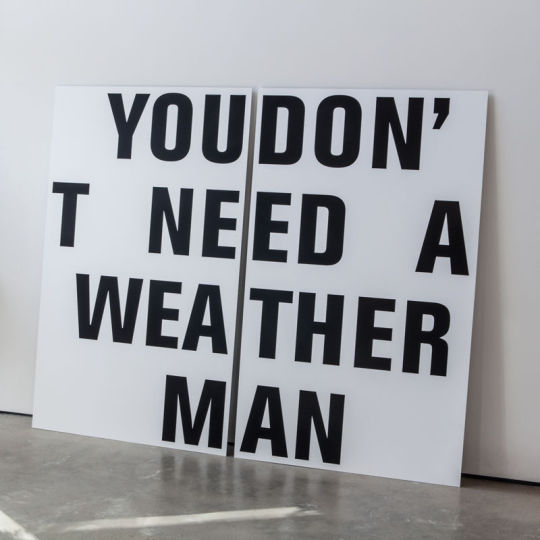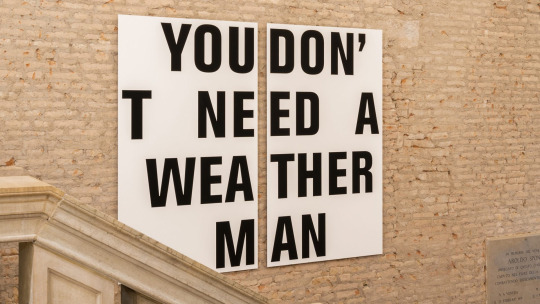#Iñigo Manglano Ovalle
Explore tagged Tumblr posts
Text


Iñigo Manglano-Ovalle
- You Don't Need a Weatherman (Version 3)
2017
#Iñigo Manglano Ovalle#Inigo Manglano Ovalle#Iñigo Manglano-Ovalle#Inigo Manglano-Ovalle#You Don't Need a Weatherman#You don't need a weatherman to know which way the wind blows#Subterranean Homesick Blues#Bob Dylan#contemporary art#slogan
28 notes
·
View notes
Text


dennis ashbaugh + iñigo manglano-ovalle in the molecular gaze: art in the genetic age - suzanne anker + dorothy nelkin (2004)
181 notes
·
View notes
Photo

This is a cloud @peterdslr Art Iñigo Manglano Ovalle
38 notes
·
View notes
Photo

IÑIGO MANGLANO-OVALLE
You don't need a weatherman, 2008
HD VIDEO LOOP, STEREO SOUND AND WEATHER STATION
89 notes
·
View notes
Photo

Mel Chin (F ‘95), Nicole Eisenman (F ‘06), LaToya Ruby Frazier (A ‘07, F ‘15), Jeffrey Gibson (F ‘14), Gary Hill (F ‘96), Toba Khedoori (A ‘90), Whitfield Lovell (A ‘95, F ‘01, ‘02, ‘05), Rick Lowe (F ‘98), Iñigo Manglano-Ovalle (F ‘02), Kerry James Marshall (F ‘98), Trevor Paglen (F ‘13), Shahzia Sikander (F ‘05), Kara Walker (F ‘01), Carrie Mae Weems (F ‘00), Fred Wilson (F ‘95), Xu Bing (F ‘03) Towards Common Cause: Art Social Change and the MacArthur Fellows Porgram at 40 Smart Museum of Art, The University of Chicago 5550 S. Greenwood Ave, Chicago, Illinois 60637 July 15 - December 19
#mel chin#nicole eisenman#latoya ruby frazier#jeffrey Gibson#gary hill#Toba Khedoori#whitfield lovell#rock lowe#iñigo manglano-ovalle#Kerry James Marshall#Trevor Paglen#shahzia sikander#Kara Walker#Carrie Mae weems#fred wilson#xu bing#alumni#faculty#chicago
15 notes
·
View notes
Photo

Iñigo Manglano-Ovalle - Weather Field No. 1
1 note
·
View note
Photo



Iñigo Manglano-Ovalle Well 34°01’03” N –118°29’12” W, 2015
500 gallons of water from Santa Clara Pueblo
69 notes
·
View notes
Photo



Iñigo Manglano-Ovalle
230 notes
·
View notes
Text
Iñigo Manglano-Ovalle
Iñigo Manglano-Ovalle uses repetition and unusualness in his work to catch the eye of viewers. For example, in his 2012 work, “Beehive grid,” the amount of boxes seem endless. This is because of how close the shot was and the positioning of the framing. This is a great example of how to correctly capture a pattern.

Another example of Inigo’s work is the El Nino Effect. There is perfect symmetry in the photo which gives it a feeling of conformity and the framing of the photo makes the exhibit much smaller.

1 note
·
View note
Photo

Glenn, Dario, and Tyrone, Iñigo Manglano-Ovalle (1998)
3 notes
·
View notes
Text

'sad light room' by iñigo manglano-ovalle, 1999 in beyond preconceptions: the sixties experiment - milena kalinovska (2000)
170 notes
·
View notes
Photo

#Repost @thealdrich . . Head up in the clouds; weekend plans?? . . Iñigo Manglano-Ovalle, Storm Prototype, 2007. Courtesy of the artist and Rhona Hoffman Gallery, Chicago. . . The Aldrich Contemporary Art Museum, October 6, 2019, to March 29, 2020. Photo 📸: Jason Mandela (at The Aldrich Contemporary Art Museum) https://www.instagram.com/p/B4kh3q3JjST/?igshid=1sgpusxbkb6y9
0 notes
Photo

Barbara Bloom (F ‘97), Nancy Graves (’63, F ‘79), Byron Kim (‘86, F ‘99, ‘13), Iñigo Manglano-Ovalle (F ‘02), Colin McMullan (’07) and others Weather Report The Aldrich 285 Main Street, Ridgefield, CT October 6, 2019 – March 29, 2020
#alumni#faculty#exhibition#1997#barbara bloom#nancy graves#1963#1979#byron kim#1986#1999#2013#governor#iñigo manglano-ovalle#2002#colin mcmullan#2007#connecticut
1 note
·
View note
Link
https://art21.org/watch/art-in-the-twenty-first-century/s8/natalia-almada-in-mexico-city-segment/
https://art21.org/watch/new-york-close-up/latoya-ruby-frazier-takes-on-levis/
https://art21.org/watch/art-in-the-twenty-first-century/s9/zanele-muholi-in-johannesburg-segment/
https://art21.org/watch/extended-play/cindy-sherman-characters-short/
0 notes
Text
SAA Jan. 28, Kramer.
S: Freeman’s articles on Framing and Pattern are detailed and provide insight into the theory of cinematography, as well as photography. “Framing” illustrates how the use of the camera as a tool, not just for taking photos of the subject but also as a force that is visible in the work itself, is essential. Rather than view the camera as a distant tool, it has an intimate connection with the object it is capturing, and its characteristics impact the way a photo or video is expressed. The camera creates the context for the photo or video, and also appears in the creation as an aesthetic element. It creates the borders of the work, and it situates the object and ultimately affects its aesthetic presence and how it impacts the viewer. “Pattern” details how the use of repeating elements can have numerous effects, such as a “centralization” of the onlooker’s attention. If a pattern is large enough and continuous enough, then it will have the effect of relaxing the viewer and allowing them to view the whole frame of the piece, instead of being drawn to one particular object. Pattern also mimics texture, and exposes certain elements through lighting. Patterns and the breaking of them can work to emphasize different elements of a work, and are often utilized to emphasize the theme of a work.
A: I found the concept of Framing itself the most exciting; one can easily manipulate an object through the use of angles, lighting, and framing. This leads the shot to emphasize different characteristics of the object, and can help the artist in communicating their specific thematic or aesthetic objectives. It opens up an array of possibilities, especially in how one looks at ordinary objects.
A: Stills from Iñigo Manglano-Ovalle’s work exemplify many of the techniques Freeman references in his analysis of framing in photography and video.

Most notably, Manglano-Ovalle utilizes “off-centering” regularly throughout his work, creating a disproportionate image. This ties into the larger aesthetic themes of the work, which emphasize the disparity between indoors and outdoors, manmade and natural, and domestic and professional. In the video the window washer is consistently pictured off to one side, creating a lopsided image that emphasizes his being in the otherwise visually “empty” space. As a quick note, pattern also plays a large role in how Manglano-Ovalle utilizes Framing; a still in which the window washer, the subject of the shot, is stationed on the side of the frame works well because the landscape behind him is highly uniform. The pattern of the trees serves as a neutral base for the viewers to briefly acknowledge; it adds dimension to the shot, but also allows us to focus on the window washer because there isn’t much to distract us from him.

There is a still in which the opposite happens; where the viewer is torn between three visual areas of interest. A woman in the house on a musical instrument, not paying attention to the outside world, is captured through a camera outside of the house peering through the window. The window-washer and a doorframe are included in the shot, effectively adding dimension to the piece and emphasizing the woman inside as the main object of interest. She is slightly off-center in comparison to the whole frame, but the inclusion of the doorframe and the window-washer places her in between those two elements, and creates a sort of visual symmetry. There is also a diagonal element in this still; the window washer’s head, the woman’s figure, and the door handle all link together to create a diagonal line, emphasizing the contrast between the three objects.

The final still depicts the woman finally looking up at the camera; she is centered. This means that the viewer’s attention is brought directly to her, and this makes her first and final interaction and acknowledgment of the camera much more visually powerful. The shot also does not picture her whole entire head; the top of it is cut off and left hidden, making the viewer’s ‘interaction’ with her through the connection of our gazes to hers more impactful because she is taking up much of the screen. Through these techniques, this moment is more powerful and more effective.
- Clare Kramer
0 notes
